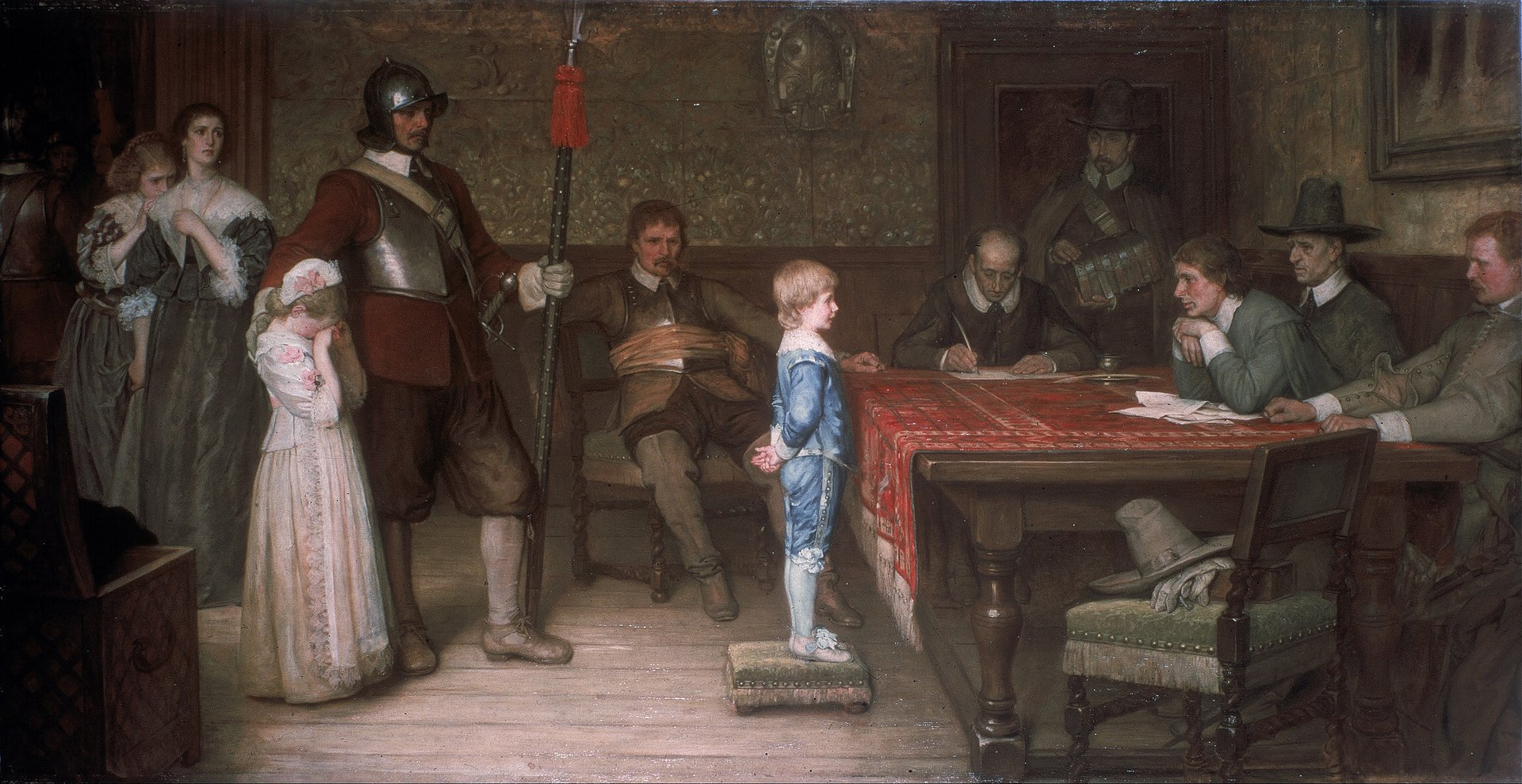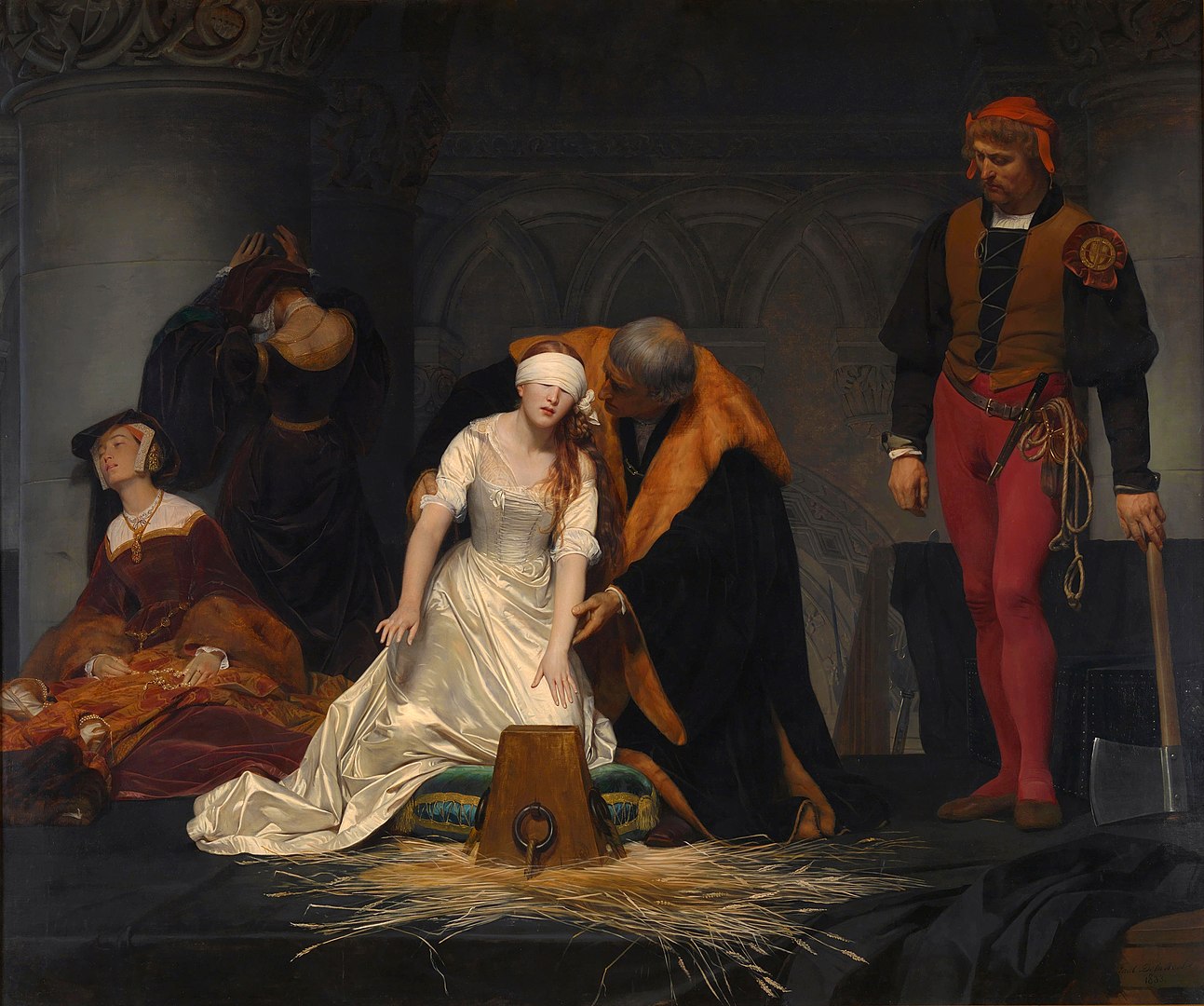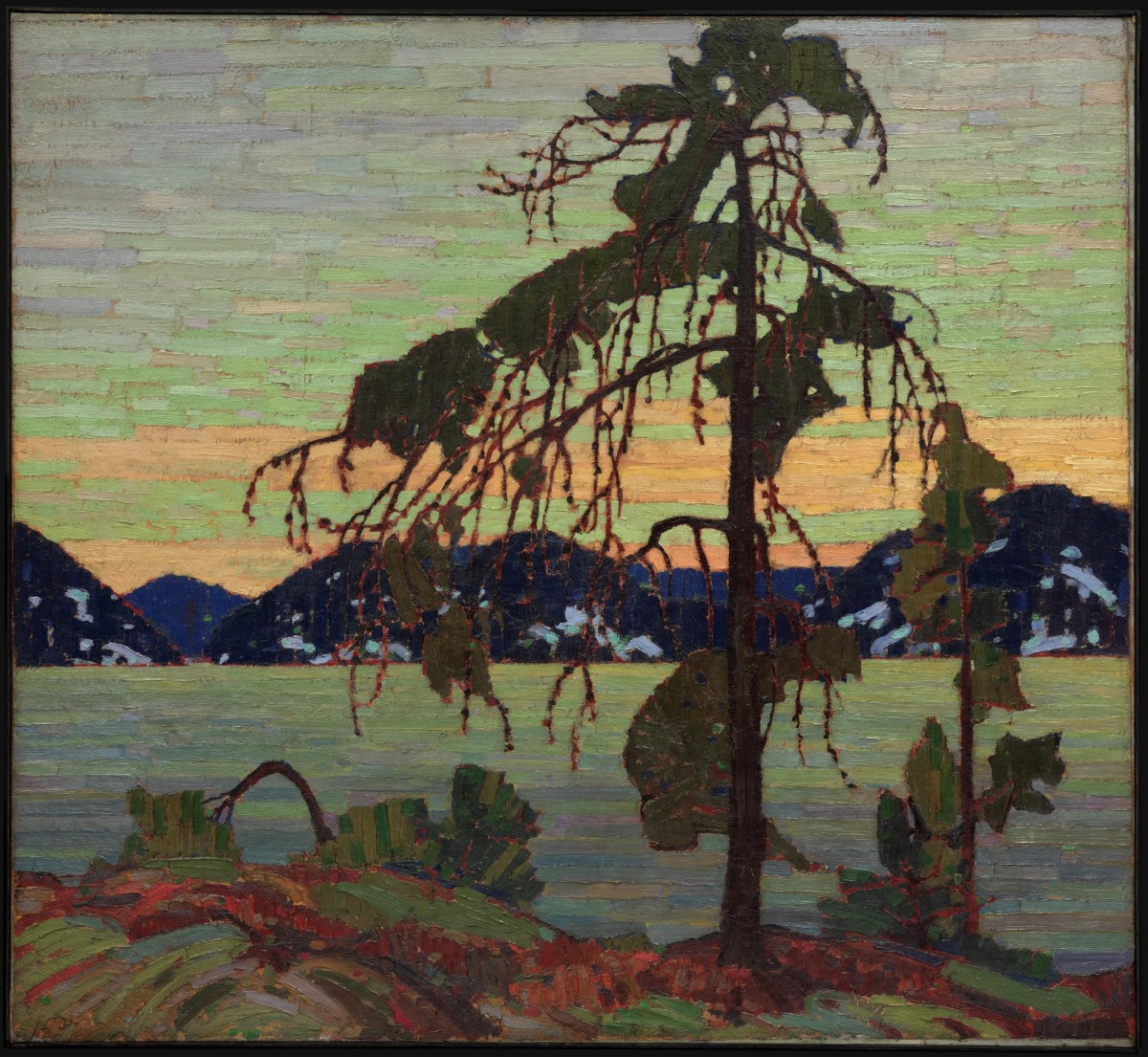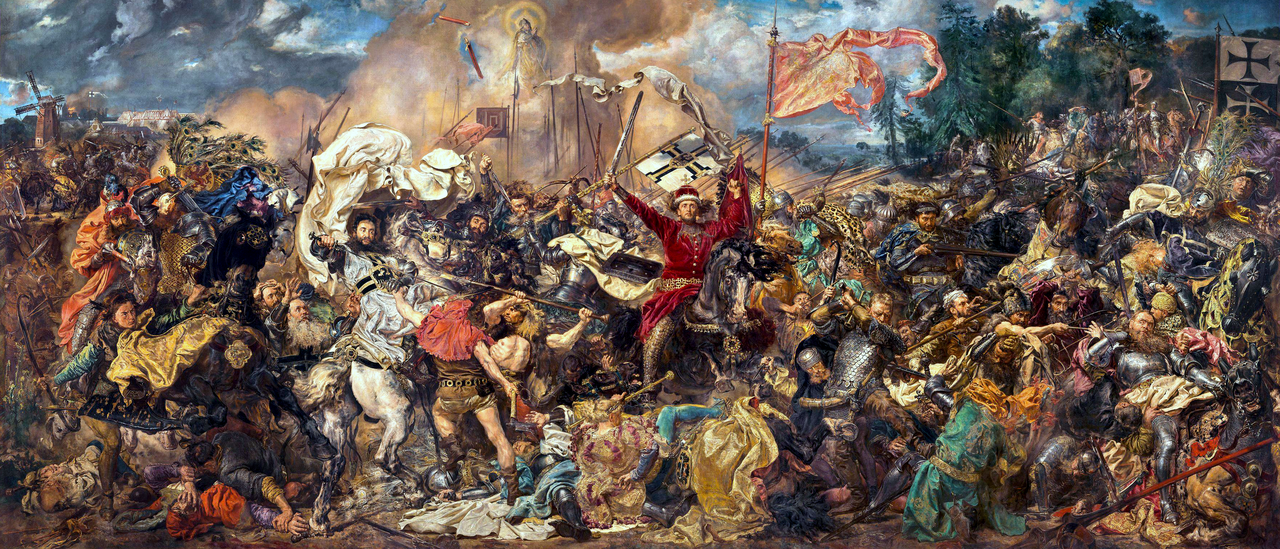I.
When I visited the National Gallery in Warsaw this year, I was struck and deeply touched to see schoolchildren being educated in front Jan Matejko’s Battle of Grunewald (1878). (Even though I am sceptical about allowing children under 12 years old into art museums.) Although I was unable to follow the Polish, I saw that the children were intent and respectful and their teachers (or museum staff) were informative and engaging. All treated the painting as something of symbolic value, partly due to the artistic achievement but also because the subject was of historical importance. I am not sure I have seen in the last decade or so any comparable scene in a British museum. I have seen plenty of school-children clustered around Van Gogh flower paintings but not around The Execution of Lady Jane Grey (1833) Paul Delaroche (1797-1856) or And When Did you Last See Your Father? (1878) by William Frederick Yeames (1835-1918).

William Frederick Yeames, And When Did you Last See Your Father? (1878)
Walker Art Gallery, Liverpool
źródło: wikimediacommons
In Great Britain, there currently is a reluctance to promote or discuss the grand paintings painted and bought for the nation in the Nineteenth Century. The big beasts of our pictorial past are troubling, not least because older people know and love the stories that the paintings illustrate. And it is that verb “illustrate” that is a painful one for curators educated through current university art-history courses. As far as today’s curators are concerned, they are embarrassed that anyone would sustain an attachment to painted narratives about real people, which might elicit emotions and draw morals from the tale. Don’t those dupes know that such art is corny propaganda? Such fustian apparitions are as tiresome as the heavy mahogany furniture and monogrammed silverware that clutter the older galleries. Why can’t visitors spend more time in the contemporary spaces, with art made by more “diverse” artists?
History painting on nationalistic subjects depends on certain foundations. The art must have a narrative structure; there must be an established set of opinions and knowledge about parties (individuals, nationalities, professions) amounting to shared values between creator and audience; finally, there must be agreement that having such values, defending them and sharing them through art is worthwhile. All of these are anathema to progressives who dominate the upper echelons of museums. They do not believe in the values of national unity; they actively oppose the idea culture based upon religious beliefs and racial/ethnic commonalities; they despise the creator of nationalist art and the audience that responds positively to it; they disagree with art of a nationalist character – if it applies to their people. By affiliation, these administrators are xenophiles, who identify more with outsiders than their own countrymen.

Paul Delaroche, The Execution of Lady Jane Grey (1833)
National Gallery, London
źródło: wikimediacommons
Research shows that in the USA white leftists identify less with their own race than with out-groups. This is a pattern that is common in Western Europe and probably also increasingly so in Eastern Europe. Western liberalism (egalitarianism, feminism, xenophilia, atheism) is seen by liberal Poles as high status and advanced, hence the emulation of Western liberalism by Poles in the upper reaches of education, culture, politics, media, the civil service and museums. This predisposes museum administrators and curators (inclined by both temperament and directed by career considerations) to disfavour art that is traditional in style, narrative in structure and nationalist in character.
This leaves popular narrative art (used for didactic purposes) out in the cold, as far as sophisticates are considered. They view the museum as a repository of the old ways of thinking about a country’s myths, the national character of its people and the significance of state boundaries. As such, it is a storehouse of toxic attitudes and lies used to manipulate uninformed people and justify antiquated prejudices. That makes the museum and its blockbuster stars targets for ire, neglect and disdain. In the case of Polish art, an ideal example is Jan Matejko (1838-1893), patriotic national painter in the History genre. Matejko’s Battle of Grunewald and Stanczyk (1862) and Jozef Simmler’s The Death of Barbara Radziwiłłówna (1860) are beloved not only for their subtlety and intelligence but because they represent significant figures in Poland’s history. They are links which parents and grandparents can transmit to their offspring the meaning of what it is to be Polish.
II.
Contempt felt for art with a strong national character and its audience is not limited to the genre of History painting. The Group of Seven, an association of Modernist landscape painters, active in 1920s and 1930s, is the defining touchstone of Canadian art. The vigorous, strongly coloured scenes of rural and wild Canada gained a huge following over the Twentieth Century. The artists seemed to embody the frontier mentality and the dramatic scenery of the far North, giving Canadian art an self-generated identity that it had never previously had, one that distinguished it from both the more-prominent USA to the south and colonial-era art by British artists. The enduring popularity of the Group of Seven is matched by the high critical regard it is held in – well, until recently.

Frank Jonhson, Reflections
źródło: wikimediacommons
Over the last decade, things have changed and it is not that Group of Seven exhibitions have been under attended or there has been a decline in sales of books and reproductions of the art. A concerted challenge to the status of that art has been mounted by curators and museum directors. In a recent exhibition of Group of Seven art (sent on tour in Europe), the catalogue introduction was written by curators charged with explaining Canadian art. In it, the art on display is attacked.
“While many Canadians still cherish these familiar images as emblems of national pride and self-representation, they are also criticized for their neglect of hard realities, such as violence toward and displacement of Indigenous communities and environmental devastation.”[i]
The painters are accused of “excluding Indigenous peoples from the images”[ii] (despite paintings of totem poles) and of overlooking environmental exploitation, apparently ignoring paintings of mining and logging included in the exhibition.

Tom Thomson, The Jack Pine (1916–17)
National Gallery of Canada, Ottawa
źródło: wikimediacommons
The distaste for this art – including its makers and its audience – is palpable in the catalogue. It is reflective of the managerial class of liberal outlook. A senior Canadian curator commented to a journalist, “I am sick of talking about the Group of Seven. That is a narrow older view of our country and we are so much more than that right now.”[iii] The subtext is that to reflect the demographics of Canada – which has experienced a massive wave of immigration from non-European countries – the national art must be adjusted, regardless of the preferences of the population. But there are also other motives distinct from aggression towards beloved art and the general audience. The business of demeaning and removing “outdated” art is accompanied by promoting and acquiring its replacement, all of which offer opportunities for earning money and prestige for supporters. In the case of Canada, there is a push to advance indigenous and new immigrant art, regardless of quality. Here is an extract of a recent article criticising the Group of Seven:
“After 101 years of reproducing the Group of Seven’s art to the point of saturation, it feels like the time has come to give other, contemporary voices the same opportunities. It’s not enough to mount gallery shows with diverse rosters—perhaps a new reproduction program, like the national series that first catapulted the Group of Seven to the masses, is needed. One that gives access for anyone who wants it, encompassing the many talented artists who reflect the lived reality of Canadians. [W]hat about the lush, sanctuary-like landscapes from Nigerian-born, Toronto-based Emmanuel Osahor hanging in classrooms from coast to coast to coast?”[iv]
It is worth noting that there is an anti-white bias, something which underpins decolonisation activism more than actually opposition to colonialism. After all, the art of immigrant Africans has even less connection with Canada than that of Canadian-born white artists. The point is to spite the white Canadian majority and force it to experience art made by newcomers who will supplant them – just the way they did to the First Nations Canadians – a paradoxically pro-colonialist attitude. Another thing worth noting is the enthusiasm for state-imposed replacement of popular art with art promoted for a specifically political agenda. The argument advanced in the mainstream press demands that resources of the state should, once in the hands of leftists, be used as a weapon against the taste of the majority. It has a degree of malicious pleasure in spiting and reshaping the population, one found in departments of culture in Communist states.
III.
If nationalists are to reclaim ground lost, they need to have nerves as steely as those of so-called moderate progressives and liberals. They need to be ruthless about promoting the art they support, refuse to support cultural schemes that undermine the cohesion of the nation and remove from posts administrators who love foreign culture more than they do native culture. Nationalists need to be more nationalistic and less the “progressives with slightly better clothes” that they have been lately. Conservatives really need to be able to refuse to perpetuate liberal innovations and brave the outrage from the leftist mainstream media that will no doubt come their way if they act according to the values of the people they serve.

Jan Matejko, Battle of Grunwald (1878)
National Museum in Warsaw
źródło: wikimediacommons
How palatable is such assertiveness to the modern conservative, who has grown up in the age of liberalism, indoctrinated to see both sides to every issue? One problem that every group has is that they see the world in terms of themselves. Liberals tend to assume most people are liberal; conservatives want to be left alone and assume that in an ideal world most people will want to be left alone. Conservatives assume that if they allow audiences to choose to engage with blockbuster populist art, that such an approach will be followed be even their political opponents. However, progressives see patriotic and populist art as actively dangerous; they despise it and want it to be actively suppressed. Supporters of such art must remember that their opponents are taking active steps to withdraw that work from display and denigrating it when it does appear. In a recent exhibition at the Tate Britain, London, the celebrated English painter William Hogarth was criticised and shamed by wall panels, most of which were written by non-experts. Will conservatives recognise this and, if so, what will they do to support blockbuster art?
Being historically literate and critically minded, I do see that Matejko and Simmler’s tableaux have more relevance and truth than Social Realism and Post-Modernist art but only relatively speaking. Authenticity in art is a chimera; what we consider authentic is dependent upon the conventions of our era. Just as a retrospective imagining of a historical situation will be compromised by the expectations of the artist (within his social context), so too there is innate relativism inherent in any statement regarding authentic national culture. After all, such definitions are at the mercy of the prevailing power. One party’s national culture is Christian, mono-ethnic and chauvinistic and another party’s national culture is secular, immigrant-welcoming and tolerant.
That sounds absurd but in Great Britain, we have been educated from 1945 onwards to the effect that British values are democracy, religious tolerance, opposition to nationalism (both that of others and our own), acceptance of refugees, political compromise, individualism, self-expression, relativism and so on. These values have been internalised to such a degree that these official standards have permeated our culture, suffocating the older traditions of self-reliance, Christianity, in-group preference, martial valour and the frontier mentality found in foreign colonisation and trade. It may be that our national culture is changing due the uniform pressure in the media, education and culture, enforced by law, led by politically minded people. Conservatives must start thinking in that way, both in order to know what to oppose and how to operate when in power. Populist art is the core of such “culture wars” – as the left has known for decades and which the conservatives are only now realising.


